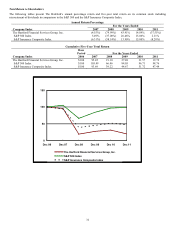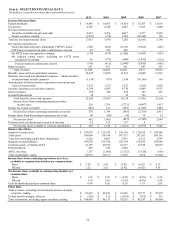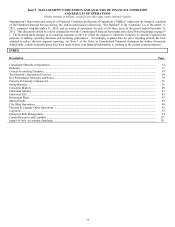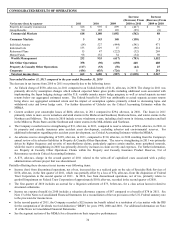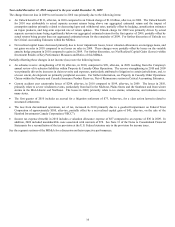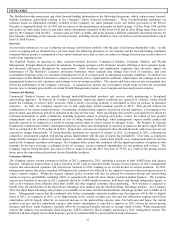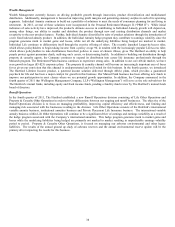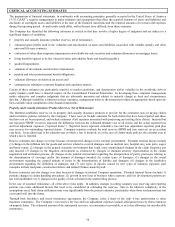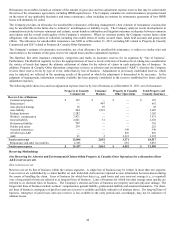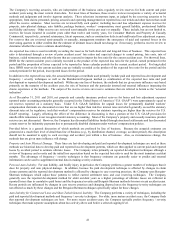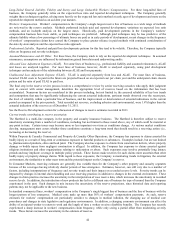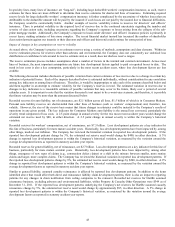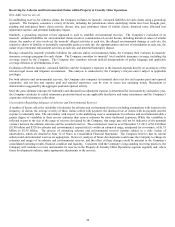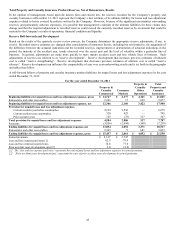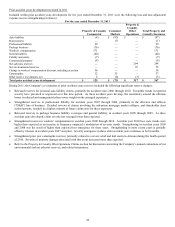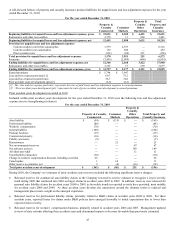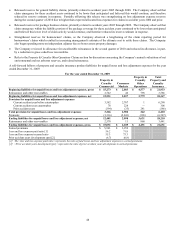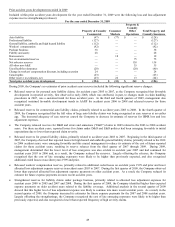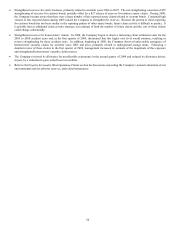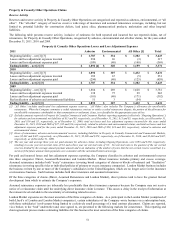The Hartford 2011 Annual Report Download - page 41
Download and view the complete annual report
Please find page 41 of the 2011 The Hartford annual report below. You can navigate through the pages in the report by either clicking on the pages listed below, or by using the keyword search tool below to find specific information within the annual report.41
The Company’ s reserving actuaries, who are independent of the business units, regularly review reserves for both current and prior
accident years using the most current claim data. For most lines of business, these reserve reviews incorporate a variety of actuarial
methods and judgments and involve rigorous analysis. These selections incorporate input, as judged by the reserving actuaries to be
appropriate, from claims personnel, pricing actuaries and operating management on reported loss cost trends and other factors that could
affect the reserve estimates. Most reserves are reviewed fully each quarter, including loss and loss adjustment expense reserves for
property, auto physical damage, auto liability, package business, workers’ compensation, most general liability, professional liability
and fidelity and surety. Other reserves are reviewed semi-annually (twice per year) or annually. These include, but are not limited to,
reserves for losses incurred in accident years older than twelve and twenty years, for Consumer Markets and Property & Casualty
Commercial, respectively, assumed reinsurance, latent exposures, such as construction defects and unallocated loss adjustment expense.
For reserves that are reviewed semi-annually or annually, management monitors the emergence of paid and reported losses in the
intervening quarters to either confirm that the estimate of ultimate losses should not change or, if necessary, perform a reserve review to
determine whether the reserve estimate should change.
An expected loss ratio is used in initially recording the reserves for both short-tail and long-tail lines of business. This expected loss
ratio is determined through a review of prior accident years’ loss ratios and expected changes to earned pricing, loss costs, mix of
business, ceded reinsurance and other factors that are expected to impact the loss ratio for the current accident year. For short-tail lines,
IBNR for the current accident year is initially recorded as the product of the expected loss ratio for the period, earned premium for the
period and the proportion of losses expected to be reported in future calendar periods for the current accident period. For long-tailed
lines, IBNR reserves for the current accident year are initially recorded as the product of the expected loss ratio for the period and the
earned premium for the period, less reported losses for the period.
In addition to the expected loss ratio, the actuarial techniques or methods used primarily include paid and reported loss development and
frequency / severity techniques as well as the Bornhuetter-Ferguson method (a combination of the expected loss ratio and paid
development or reported development method). Within any one line of business, the methods that are given more influence vary based
primarily on the maturity of the accident year, the mix of business and the particular internal and external influences impacting the
claims experience or the methods. The output of the reserve reviews are reserve estimates that are referred to herein as the “actuarial
indication”.
As of December 31, 2011 and 2010, net property and casualty insurance product reserves for losses and loss adjustment expenses
reported under accounting principles generally accepted in the United States of America (“U.S. GAAP”) were approximately equal to
net reserves reported on a statutory basis. Under U.S. GAAP, liabilities for unpaid losses for permanently disabled workers’
compensation claimants are discounted at rates that are no higher than risk-free interest rates and which generally exceed the statutory
discount rates set by regulators, such that workers’ compensation reserves for statutory reporting are higher than the reserves for U.S.
GAAP reporting. Largely offsetting the effect of the difference in discounting is that a portion of the U.S. GAAP provision for
uncollectible reinsurance is not recognized under statutory accounting. Most of the Company’ s property and casualty insurance product
reserves are not discounted. However, the Company has discounted liabilities funded through structured settlements and has discounted
certain reserves for indemnity payments due to permanently disabled claimants under workers' compensation policies.
Provided below is a general discussion of which methods are preferred by line of business. Because the actuarial estimates are
generated at a much finer level of detail than line of business (e.g., by distribution channel, coverage, accident period), this description
should not be assumed to apply to each coverage and accident year within a line of business. Also, as circumstances change, the
methods that are given more influence will change.
Property and Auto Physical Damage. These lines are fast-developing and paid and reported development techniques are used as these
methods use historical data to develop paid and reported loss development patterns, which are then applied to current paid and reported
losses by accident period to estimate ultimate losses. The Company relies primarily on reported development techniques although a
review of frequency and severity and the initial loss expectation based on the expected loss ratio is used for the most immature accident
months. The advantage of frequency / severity techniques is that frequency estimates are generally easier to predict and external
information can be used to supplement internal data in making severity estimates.
Personal Auto Liability. For auto liability, and bodily injury in particular, the Company performs a greater number of techniques than it
does for property and auto physical damage. In addition, because the paid development technique is affected by changes in claim
closure patterns and the reported development method is affected by changes in case reserving practices, the Company uses Berquist-
Sherman techniques which adjust these patterns to reflect current settlement rates and case reserving techniques. The Company
generally uses the reported development method for older accident years as a higher percentage of ultimate losses are reflected in
reported losses than in cumulative paid losses and the frequency/severity and Berquist-Sherman methods for more recent accident years.
Recent periods are influenced by changes in case reserve practices and changing disposal rates; the frequency/severity techniques are
not affected as much by these changes and the Berquist-Sherman techniques specifically adjust for these changes.
Auto Liability for Commercial Lines and Short-Tailed General Liability. The Company performs a variety of techniques, including the
paid and reported development methods and frequency / severity techniques. For older, more mature accident years, the Company finds
that reported development techniques are best. For more recent accident years, the Company typically prefers frequency / severity
techniques that make separate assumptions about loss activity above and below a selected capping level.


